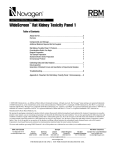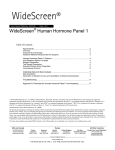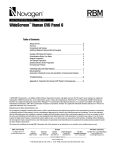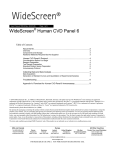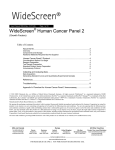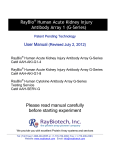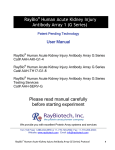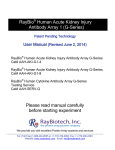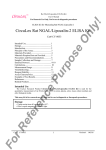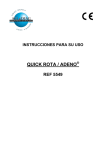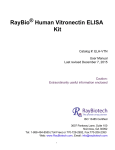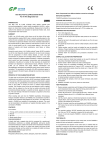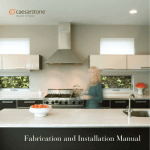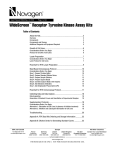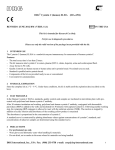Download About the Kits
Transcript
Novagen User Protocol TB523 Rev. A 0109 Page 1 of 9 TM WideScreen Rat Kidney Toxicity Panel 2 Table of Contents About the Kit ...........................................................................................2 Overview Components and Storage Additional Materials Required But Not Supplied 2 3 3 Rat Kidney Toxicity Panel 2 Protocol.......................................................4 Considerations Before You Begin Reagent Preparation Test Sample Preparation Standard Dilution Series Preparation Immunoassay Protocol 4 4 5 5 5 Collecting Data and Data Analysis ...........................................................7 Data Acquisition Generation of Standard Curves and Quantitation of Experimental Samples 7 7 Troubleshooting ......................................................................................8 Appendix A: Flowchart for Rat Kidney Toxicity Panel 2 Immunoassay ....9 © 2009 EMD Chemicals Inc., an Affiliate of Merck KGaA, Darmstadt, Germany. All rights reserved. The Novagen® name and logo are registered trademarks of EMD Chemicals Inc. in the United States and in certain other jurisdictions. WideScreen™ is a trademark of EMD Chemicals Inc. Bio-Plex® is a registered trademark and Bio-Plex® Manager™ is a trademark of Bio-Rad Laboratories, Inc. Luminex® and xMAP® are registered trademarks and Luminex® 100™ IS is a trademark of Luminex Corporation. ProClin® is a registered trademark of Rohm and Haas Co. Tween® is a registered trademark of ICI Americas Inc. Manufactured by Rules Based Medicine, Inc. By opening the packaging containing this product (which contains fluorescently labeled microsphere beads authorized by Luminex Corporation) or using this product in any manner, you are consenting and agreeing to be bound by the following terms and conditions. You are also agreeing that the following terms and conditions constitute a legally valid and binding contract that is enforceable against you. If you do not agree to all of the terms and conditions set forth below, you must promptly return this product for a full refund prior to using it in any manner. You, the buyer, acquire the right under Luminex Corporation’s patent rights, if any, to use the product or any portion of this product, including without limitation the microsphere beads contained herein, only with Luminex Corporation’s laser-based fluorescent analytical test instrumentation marketed under the name Luminex Instrument. The terms and conditions governing EMD Chemicals’ sale of this product are as indicated on our website (www.emdbiosciences.com). USA and Canada Tel (800) 526-7319 [email protected] Europe France Freephone 0800 126 461 Germany Freecall 0800 100 3496 Ireland Toll Free 1800 409 445 All Other Countries United Kingdom Freephone 0800 622 935 All other Contact Your Local Distributor www.novagen.com European Countries [email protected] +44 115 943 0840 ———————————————— [email protected] ——————————————— www.novagen.com FOR RESEARCH USE ONLY. NOT FOR HUMAN OR DIAGNOSTIC USE. Cat. No. User Protocol TB523 Rev. A 0109 Page 2 of 9 Page About the Kit WideScreen™ Rat Kidney Toxicity Panel 2 72174-3 Overview Bead-based flow cytometric assays enable sensitive, precise quantitation of analytes within a sample. When directed toward proteins or peptides, such assays are essentially ELISAs on a bead. Samples are combined with fluorescently labeled microparticles (beads) covalently conjugated to a capture antibody. Analytes captured on the beads are identified with detection antibodies and a fluorescent label. A major advantage of bead-based assays over traditional protein quantitation methods (such as ELISA) is the capacity for multiplexing, as bead-based assays allow simultaneous quantitation of multiple analytes in a small sample volume. WideScreen™ Rat Kidney Toxicity Panel 2 is a pre-mixed multiplex bead kit of antibody-based assays for simultaneous quantitation of five kidney damage biomarkers in rat urine and plasma. Analyte Full / Alternate name Calbindin Calbindin Clusterin Clusterin / Apolipoprotein J Cystatin C Cystatin C NGAL Neutrophil gelatinase-associated lipocalin Osteopontin Osteopontin An essential aspect of drug development is determining detrimental side effects, preferably prior to clinical trials. The WideScreen Rat Kidney Toxicity Panels measure key biomarkers found in urine that can indicate drug-induced damage to kidneys, known as renal toxicity or nephrotoxicity. Traditional tests of this nature test for biomarkers that are detectable days or weeks after kidney damage has occurred. In contrast, the WideScreen Rat Kidney Toxicity Panels provide researchers with a tool to detect biomarkers which may be upregulated and reveal damage within hours, allowing drugs to be efficiently and rigorously tested before human clinical trials begin. • Calbindin is a calcium binding protein found in epithelial cells involved in Ca2+ transport, including those in the cortical collecting tubules of the kidney. • Clusterin is a highly conserved protein that is elevated following apoptotic cell death in a variety of tissues, establishing it as a marker of apoptotic cell loss. • Cystatin C is an extracellular inhibitor of cysteine proteases and is normally expressed in vascular smooth muscle cells. Cystatin C levels correlate inversely with glomerular filtration rate. • NGAL is a protease resistant polypeptide detected in urine shortly following renal ischemia. • Osteopontin promotes inflammation at sites of tissue injury and is upregulated following renal ischemia. The WideScreen Rat Kidney Toxicity Panel 2 is a pre-mixed multiplex bead kit of quantitative antibodybased assays for simultaneous detection of five proteins found in rat urine and associated with kidney damage: calbindin, clusterin, cystatin C, NGAL, and osteopontin. The kit includes all the reagents and buffers needed to analyze the above proteins in rat urine samples using the Luminex® xMAP® System. Note: USA and Canada Tel (800) 526-7319 [email protected] WideScreen™ Rat Kidney Toxicity Panel 2 can also be used with rat plasma samples. Please refer to sample preparation section on p 5. Germany Tel 0800 100 3496 [email protected] United Kingdom and Ireland UK Freephone 0800 622935 Ireland Toll Free 1800 409445 [email protected] All Other Countries www.novagen.com [email protected] Cat. No. User Protocol TB523 Rev. A 0109 Page 3 of 9 Page Components and Storage The kit includes all the reagents and buffers needed to assay the above proteins in rat urine samples using the Luminex® xMAP® System. The kit contains sufficient components to assay one 96-well plate. WideScreen™ Rat Kidney Toxicity Panel 2 1.1 ml Rat Kidney Toxicity Panel 2 Capture Beads 72174-3 ® PBS with BSA, Tween 20 and 0.025% ProClin 300 1 vial Rat Kidney Toxicity Panel 2 Detection Antibodies Lyophilized, biotinylated detection antibody premix 1 vial Rat Kidney Toxicity Panel 2 Standards Mix Lyophilized recombinant protein standards for calbindin, clusterin, cystatin C, NGAL, and osteopontin 1 vial Rat Kidney Toxicity Panel 2 Control 1 Lyophilized, low levels of calbindin, clusterin, cystatin C, NGAL, and osteopontin 1 vial Rat Kidney Toxicity Panel 2 Control 2 Lyophilized, high levels of calbindin, clusterin, cystatin C, NGAL, and osteopontin 60 ml Assay Buffer Type 2 1X, proprietary mix of domestic animal proteins in PBS with 0.025% ProClin 300 1 vial Store all components at 4°C* Blocking Buffer Type 4 Lyophilized, proprietary mix of domestic animal proteins to minimize non-specific interactions 60 ml Sample Dilution Buffer Type 3 1X, proprietary mix of domestic animal proteins in PBS with 0.025% ProClin 300 1 vial Standard Curve Diluent Type 5 Lyophilized, proprietary mix of domestic animal proteins 150 µl 15X Streptavidin-Phycoerythrin PBS with 2 mM NaN3 1 96-well Filter Plate and Sealer *Following reconstitution of lyophilized reagents, store any unused reagent at –70°C. See Reagent Preparation section (p 4). Note: WideScreen™ Rat Kidney Toxicity Panel 2 is not compatible with other bead kits and buffers sold by EMD or other vendors. Caution: All materials derived from animal fluids or tissues should be considered biohazardous and handled accordingly. Refer to MSDS for additional information. Additional Materials Required But Not Supplied • • • • • • • • USA and Canada Tel (800) 526-7319 [email protected] Luminex® xMAP® System (or equivalent) Vacuum manifold for filter plates (Pall 5017 or Millipore MSVMHTS00) 96-well plate platform shaker, such as IKA MTS4 Polypropylene microcentrifuge tubes 15 ml polypropylene centrifuge tubes Vortex mixer Ultrasonic bath, such as Cole Parmer EW-08849 (optional) Multichannel pipet (optional) Germany Tel 0800 100 3496 [email protected] United Kingdom and Ireland UK Freephone 0800 622935 Ireland Toll Free 1800 409445 [email protected] All Other Countries www.novagen.com [email protected] Cat. No. User Protocol TB523 Rev. A 0109 Page 4 of 9 Page Rat Kidney Toxicity Panel 2 Protocol Considerations Before You Begin • Guidelines when using filter plates and vacuum manifold: • Excessive vacuum will cause the filter plate membrane to perforate. Adjust the pressure using a non-filter (ELISA or tissue culture) plate, ensuring that vacuum does not exceed 5 in. (127 mm) Hg. • After adjusting the vacuum with a non-filter plate, place filter plate on the manifold. Use fingertips to apply pressure evenly across the plate. The liquid should drain in 2–5 sec. • To avoid drying out the beads, vacuum only long enough to drain all wells. Do not allow drained beads to sit for >5 min before rehydrating with buffer. • It is critical to remove excess buffer from the underside of the filter plate by tapping it on a paper towel several times before adding samples or reagents. This prevents samples from wicking out of the wells during incubation steps. For the same reason, avoid placing filter plate on an absorbent surface during incubations. • To avoid perforating the filter plate membrane, make certain that the probe height on the xMAP® system is adjusted correctly. Do not touch the membrane with pipet tips. For accurate pipetting, touch tips to the sides of the filter plate wells. Change tips as necessary to prevent crosscontamination. • Capture Beads and Streptavidin-PE are light sensitive. To avoid photobleaching, keep beads and Streptavidin-PE in microcentrifuge tubes covered. Cover filter plates with aluminum foil during incubation steps. • To prevent fluorescent dye loss, do not use organic solvents with capture beads. Beads are incompatible with DMSO concentrations >1%. • Many of the washing and reagent dispensing steps may be done with an 8-channel or 12-channel pipet (manual or automatic). For accurate results, use calibrated single-channel pipets for manipulation of standards and test samples. • Test samples should be stored at –70°C prior to use. Reagent Preparation 1. Resuspend each of the following lyophilized reagents in deionized water, immediately prior to performing the assay: Reagent Rat Kidney Toxicity Panel 2 Standards Mix Rat Kidney Toxicity Panel 2 Control 1 Rat Kidney Toxicity Panel 2 Control 2 Blocking Buffer Type 4 Standard Curve Diluent Type 5 Rat Kidney Toxicity Panel 2 Detection Antibodies 2. Note: USA and Canada Tel (800) 526-7319 [email protected] dH2O Volume 150 µl 100 µl 100 µl 1.5 ml 1.0 ml 4.4 ml Mix each vial by vortexing at medium speed for 15 sec. Incubate at room temperature for a minimum of 5 min (not to exceed 30 min) and repeat vortexing step. Rat Kidney Toxicity Panel 2 Detection Antibodies can remain at room temperature for up to 2 hours. Following reconstitution, store any unused reagents at –70°C. Unused reagents can be stored at –70°C for up to one month. Avoid multiple freeze-thaw cycles. Germany Tel 0800 100 3496 [email protected] United Kingdom and Ireland UK Freephone 0800 622935 Ireland Toll Free 1800 409445 [email protected] All Other Countries www.novagen.com [email protected] Cat. No. User Protocol TB523 Rev. A 0109 Page 5 of 9 Page Test Sample Preparation Notes: 1. Thaw and dilute samples within 1 h of use. Remove any particulates by centrifugation or filtration. Avoid multiple freeze/thaw cycles. 2. Dilute urine samples 50-fold in Sample Dilution Buffer Type 3. For preparing duplicate samples (recommended), mix 2 µl sample + 98 µl Sample Dilution Buffer Type 3. Mix well and store on ice. 3. Higher or lower urine sample dilutions may be required to ensure readings within the ranges of the assay standards, and should be determined empirically. While 1:50 is the recommended starting point for this multiplex panel, dilutions as low as 1:10 are acceptable for quantifying low target levels, and a dilution range of 1:1000–100,000 may be necessary for cystatin C, depending upon the level of kidney damage. Perform all sample dilutions in Sample Dilution Buffer Type 3. For higher dilutions, a two step process is recommended for accuracy, such as a 1:100 followed by a 1:100 = 10,000 final dilution. WideScreen™ Rat Kidney Toxicity Panel 2 can also be used with rat plasma samples. The optimal dilution for plasma samples must be determined empirically. However, as a starting point, we recommend a 5-fold dilution in Sample Dilution Buffer Type 3. For examples of dilutions used for plasma and urine samples, see the Representative Data section of the Certificate of Analysis. Standard Dilution Series Preparation This preparation provides sufficient volume to run duplicate standard dilution curves. Label 8 polypropylene tubes S8 through S1. Alternatively, prepare standard dilutions in a 96-well plate. Pipet Standard Curve Diluent Type 5 into labeled tubes as described below. Transfer the reconstituted Rat Kidney Toxicity Panel 2 Standards Mix to the S8-labeled tube. Prepare 3-fold serial dilutions of S8 following the table below. Ensure that each new standard is mixed well by vortexing before proceeding to the next dilution. Change tips between each dilution. Note: Standard Volume of Standard Curve Diluent Type 5 Volume of Standards Mix S8 S7 0 µl 80 µl 150 µl from vial 40 µl of S8 S6 80 µl 40 µl of S7 S5 80 µl 40 µl of S6 S4 80 µl 40 µl of S5 S3 80 µl 40 µl of S4 S2 80 µl 40 µl of S3 S1 80 µl 40 µl of S2 Standard concentrations are lot-specific. Refer to Certificate of Analysis of appropriate lot for specific standard concentrations. Immunoassay Protocol Note: USA and Canada Tel (800) 526-7319 [email protected] 1. Seal any unused wells of the 96-well filter plate with plate sealer (included) or lab tape for future use. 2. Pre-wet 96-well filter plate wells with 50 µl Assay Buffer Type 2 and incubate for a minimum of 5 min. Immediately prior to Step 3, remove liquid from filter plate by vacuum filtration. Do not exceed 5 in. Hg or 127 mm Hg vacuum; liquid should drain in 2–5 sec. Tap filter plate on a paper towel to remove any buffer remaining on the underside. It is critical to remove excess buffer from the underside of the filter plate before adding samples or reagents. Otherwise, samples may wick out of the wells during incubation steps. For the same reason, avoid placing filter plate on an absorbent surface during incubations. If a well does not Germany Tel 0800 100 3496 [email protected] United Kingdom and Ireland UK Freephone 0800 622935 Ireland Toll Free 1800 409445 [email protected] All Other Countries www.novagen.com [email protected] Cat. No. User Protocol TB523 Rev. A 0109 Page 6 of 9 Page drain, use the non-tip end of a 200 µl pipet tip to flick the center of the plastic support on the underside of the well, then reapply vacuum. 3. Add 10 µl of Blocking Buffer Type 4 to each filter plate well that will be used. 4. Add 30 µl of each standard, sample or control to appropriate well of the 96-well filter plate. Note: Rat Kidney Toxicity Panel 2 Control 1 and Control 2 do not need to be diluted. Note: Gradually increase the vortex speed from low to medium. Hold the plate with a loose grip. Mix thoroughly for 10 sec. Avoid splashing. Alternatively, mix using a plate shaker for 10 sec on high speed (1200 rpm). 5. Vortex the plate by gently gliding the plate over the vortex mixer. 6. Sonicate 10 sec (optional) and vortex the tube of Rat Kidney Toxicity Panel 2 Capture Beads for 10 sec. Add 10 µl to each well. 7. Vortex or shake the plate 10 sec as described above in Step 5. 8. Cover plate with aluminum foil to protect from light and incubate 1 hr at room temperature on a plate shaker (750 rpm). 9. Remove liquid from filter plate by vacuum filtration (5 in. Hg or 127 mm Hg maximum). 10. Wash beads by adding 100 µl Assay Buffer Type 2 to each well and applying vacuum to remove buffer. Repeat wash step for total of two washes in Assay Buffer Type 2. After the second wash and vacuum, tap the filter plate on paper towels to remove any buffer remaining on the underside. Note: Do not resuspend beads in Assay Buffer Type 2 after second wash. 11. Add 40 µl Rat Kidney Toxicity Panel 2 Detection Antibodies to each well. Vortex or shake the plate as described in Step 5. 12. Cover plate with aluminum foil to protect from light and incubate 1 h at room temperature on a plate shaker (750 rpm) Note: Do not wash beads after Detection Antibody incubation. 13. Microcentrifuge 15X Streptavidin-PE briefly (5 sec) to ensure all material is in the bottom of the tube. If using all 96 wells, dilute 15X Streptavidin-PE to 1X by adding 144 µl concentrated Streptavidin-PE to 2016 µl Assay Buffer Type 2. Note: Do not dilute the whole vial of Streptavidin-PE if the entire kit will not be used. Dilute only what is needed based on the number of wells. Allow 10% extra for pipetting error. If there is an insufficient volume of 15X Streptavidin-PE for your final experiment, making a slightly more dilute working stock will not adversely affect results. 14. Add 20 µl 1X Streptavidin-PE to each well. 15. Cover plate with aluminum foil to protect from light and incubate 30 min at room temperature on a plate shaker (750 rpm). 16. Remove liquid from filter plate by vacuum filtration. 17. Wash beads by adding 100 µl Assay Buffer Type 2 to each well and applying vacuum to remove buffer. Repeat wash step for total of two washes in Assay Buffer Type 2. After second wash and vacuum, tap filter plate on paper towels to remove any buffer remaining on the underside. 18. Add 100 µl Assay Buffer Type 2 to each well. 19. Cover plate to protect from light. Incubate 3–5 min at room temperature on a plate shaker (750 rpm). 20. Analyze using a Luminex® instrument. USA and Canada Tel (800) 526-7319 [email protected] Germany Tel 0800 100 3496 [email protected] United Kingdom and Ireland UK Freephone 0800 622935 Ireland Toll Free 1800 409445 [email protected] All Other Countries www.novagen.com [email protected] Cat. No. User Protocol TB523 Rev. A 0109 Page 7 of 9 Page Collecting Data and Data Analysis Data Acquisition For detailed instructions on the operation of Luminex® systems, refer to the user guide for your specific instrument and software. General recommendations are given below. 1. Note: Using your Luminex system software, prepare a protocol for the assay you will run. Enter information for each bead target, and for the standards, samples, and controls. Standard concentrations are lot-specific. Refer to Certificate of Analysis of appropriate lot for specific standard concentrations. 2. Select the following bead regions: Analyte Bead Region Analyte Bead Region Calbindin 62 NGAL 50 Clusterin 12 Osteopontin 52 Cystatin C 44 3. Acquire data using the system settings shown below: Software Sample Size Events per Bead Region Timeout Doublet Discriminator CAL2 Gain Setting Luminex® IS™ or equivalent 50 µl 50–100* 60 sec 7500–15500 default Bio-Plex® Manager™ default (50 µl) 50–100* 60 sec default (4335–10000) RP1 low *If the time spent acquiring samples needs to be reduced, collect as few as 50 events per bead region. Generation of Standard Curves and Quantitation of Experimental Samples • Protein standards are supplied in the Rat Kidney Toxicity Panel 2 kit, allowing for accurate quantitation using a titrated standard curve. Representative standard curves and assay performance information can be found in the Certificate of Analysis for the specific lot. • Refer to the Certificate of Analysis for expected control ranges. • The eight data points obtained with the concentration standards are plotted using Median Fluorescent Intensity (MFI) as the signal readout (Y-axis), against concentration of standard dilutions (X-axis). • Five-parameter logistic (5PL) curve fitting is recommended for modeling data obtained from bead-based immunoassays. Most ranges of standard concentrations are too wide for accurate linear regression analysis. Four-parameter logistic (4PL) equations will often give a good fit, but are not ideal because they assume the standard curve is symmetrical. • If the signal from an unknown sample exceeds the highest point of the standard curve, the concentration of the unknown should not be calculated by extrapolation, because the non-linear shape of the standard curve cannot be accurately modeled past the last measured point. In this case, dilute the samples and test again. • When concentrations of unknowns have been determined by reading off of the standard curve, remember to multiply this value by the dilution factor to obtain the concentration of the target in the original sample. USA and Canada Tel (800) 526-7319 [email protected] Germany Tel 0800 100 3496 [email protected] United Kingdom and Ireland UK Freephone 0800 622935 Ireland Toll Free 1800 409445 [email protected] All Other Countries www.novagen.com [email protected] Cat. No. User Protocol TB523 Rev. A 0109 Page 8 of 9 Page Troubleshooting Problem Leaking wells in filter plate Probable Cause Wicking due to adherent drops Solution Tap filter plate several times on paper towel before adding samples or reagents. Do not place filter plate on an absorbent surface during incubations. If wells leaked during data acquisition, it is possible to reacquire these wells. Blot underside of wells and add 100 μl/well Assay Buffer Type 2. Perforation of filter plate membranes Filter plate wells not draining under vacuum Vacuum is too low Adjust the vacuum setting to <5 in. (127 mm) Hg. Do not touch membranes with pipet tips. Adjust vacuum setting to 3–5 in. (76–127 mm) Hg. Clean rubber seals. Apply fingertip pressure to filter plate to ensure formation of a good seal. Use the plate sealer to cover wells not in use. Clogged membranes Clarify samples by centrifugation or filtration. If samples are viscous, dilute further before assaying. Use the non-tip end of a 200 µl pipette to flick the center support on the underside of the well, then reapply vacuum. Low bead counts during data acquisition No beads in the wells See “Leaking wells in filter plate” solutions above. Verify that beads were added at the correct concentration, and that correct bead regions and wells were selected during acquisition setup. xMAP® fluidics system is clogged Clear system of clogs or air using maintenance steps described in the instrument user manual (sanitize, alcohol flush, probe sonication, etc.). Make sure that the probe height is set correctly. Make sure that beads are in suspension by incubating plate for 3–5 min on plate shaker (750 rpm) immediately before analysis. Microbial growth in buffers can cause beads to stick to the filter plate membrane. Do not use contaminated reagents. Beads are not falling into the gates properly Timeout limit is set too low 50–100 events per bead region should be acquired within the 60 sec timeout limit. If necessary, the timeout limit can be set higher, e.g. 75 sec. Beads were not resuspended in Assay Buffer Type 2 before analysis The setting of the Doublet Discriminator (DD) gate is buffer-specific. This gate can be adjusted, but Assay Buffer Type 2 is the recommended buffer for running samples. Other buffers may cause bead aggregation. DD gate setting not optimal Use the DD gate setting recommended in the Data Acquisition Section. If necessary, raw data results can be reanalyzed with different DD gate settings; see software user manual. Beads were exposed to organic solvents Do not use organic solvents in the immunoassay, as they will damage beads irreversibly. Beads are falling outside the bead region gates due to photobleaching Do not use expired beads. Fluidics system is not running properly Confirm that the waste container is not full, the sheath fluid is not empty, and the SD fluidics module is turned on. Do not expose the beads to ambient light for >10 min. Avoid intense light. Check system calibration using approved calibration beads. Verify correct system pressure. Confirm that the system is free of air or particulate buildup. Follow maintenance steps in the instrument user manual. Insufficient volume of an immunoassay reagent Solutions were not prepared or used as described in protocol Briefly spin tubes to collect reagents that might be trapped in the tube cap. Confirm correct buffer dilutions and use. If additional Assay Buffer Type 2 is needed, PBS can be used for the final bead resuspension step. If additional 96-well filter plates are required, we recommend Millipore Cat. No. MSBVN1210. If there is insufficient volume of 15X Streptavidin-PE for your final experiment, making a slightly more dilute working stock (e.g., 20-fold instead of 15-fold) will not adversely affect results. Sample measurements not within the standard curve USA and Canada Tel (800) 526-7319 [email protected] Dilution of sample is too low or too high If values are higher than the standard curve, dilute samples further in Sample Dilution Buffer Type 3 and repeat assay. Target concentration is below detection Verify that curve fitting at the lower end of the standard curve is accurate. Germany Tel 0800 100 3496 [email protected] Not all urine and plasma samples contain detectable levels of all analytes. United Kingdom and Ireland UK Freephone 0800 622935 Ireland Toll Free 1800 409445 [email protected] All Other Countries www.novagen.com [email protected] Cat. No. User Protocol TB523 Rev. A 0109 Page 9 of 9 Page Appendix A: Flowchart for Rat Kidney Toxicity Panel 2 Immunoassay Pre-wet Filter Plate • Add 50 μl Assay Buffer Type 2 to each well being used Prepare Reagents • Reconstitute all lyophilized reagents: − Standards Mix (150 μl dH2O) − Controls 1 and 2 (100 μl dH20 each) − Blocking Buffer (1.5 ml dH20) − Standard Curve Diluent (1.0 ml dH20) − Detection Antibodies (4.4 ml dH20) Prepare 8-point Standard Dilution Series Duplicates Prepare Diluted Test Samples • 80 μl Standard Curve Diluent Type 5 in tubes S7–S1 • 150 μl Standards Mix in tube S8 • 3-fold serial dilutions, mix thoroughly (40 μl from tube S8 to tube S7, etc.) • Dilute urine 50-fold in Sample Dilution Buffer Type 3 • If further dilutions are needed, perform in Sample Dilution Buffer Type 3 Blocker/Analyte/Capture Bead Incubation • Remove liquid from pre-wet filter plate by vacuum • Add 10 μl Blocking Buffer per well being used • Add 30 μl of the following and mix: − Test sample (diluted), or − Controls 1 or 2 (undiluted), or − Standard Dilution Series • Vortex/sonicate Capture Beads Premix • Add 10 μl Capture Beads Premix to each well • Vortex/mix plate 10 sec • Shake for 1 h (750 rpm, room temperature, in the dark) Detection Antibody Incubation • • • • • Wash and vacuum plate 2X (100 μl Assay Buffer Type 2) Add 40 μl Detection Antibodies mix to each well Vortex/mix plate 10 sec Shake for 1 h (750 rpm, room temperature, in the dark) NOTE: Do NOT wash or vacuum filter plate after incubation Streptavidin-PE (SA-PE) Incubation • Dilute 15X SA-PE as needed. For entire plate: − Add 144 μl 15X SA-PE + 2016 μl Assay Buffer Type 2 • Add 20 μl diluted (1X) SA-PE to each well • Shake for 30 min (750 rpm, room temperature, in the dark) • Wash and vacuum plate 2X (100 μl Assay Buffer Type 2) • Resuspend beads in 100 μl Assay Buffer Type 2 Analysis • Shake approx. 5 min (750 rpm, room temperature, in the dark) Analyze on xMAP® system: • Low Gain RP1 setting (BioPlex®) • DD Gate: 7500–15500 (Luminex®) or default (BioPlex) • Sample size: 50 μl • Collect 50–100 events per bead region • Timeout: 60 sec USA and Canada Tel (800) 526-7319 [email protected] Germany Tel 0800 100 3496 [email protected] United Kingdom and Ireland UK Freephone 0800 622935 Ireland Toll Free 1800 409445 [email protected] All Other Countries www.novagen.com [email protected]









